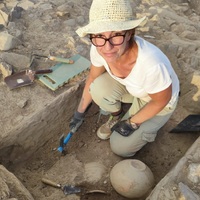Papers by C Margaret Scarry
University Press of Florida eBooks, Dec 30, 2022
his article constitutes the first of two reports on fieldwork conducted at Azoria in eastern Cret... more his article constitutes the first of two reports on fieldwork conducted at Azoria in eastern Crete during the 2003 and 2004 excavation seasons. The focus of excavation was on the South Acropolis, where buildings of Archaic date (7th-early 5th century b.c.) suggesting public or civic functions have come to light. The complex includes a possible andreion on the west slope, a cult building on the terrace south of the peak, and storerooms and kitchens associated with a monumental public building on the southwest terrace. A 3rd-century b.c. dump on the southeast slope provides important information about the limited reoccupation of the site in the Hellenistic period
The Florida Anthropologist, 1985

Journal of Anthropological Archaeology, 2016
The south Florida Calusa are noted for their complex social organization coupled with their forag... more The south Florida Calusa are noted for their complex social organization coupled with their forager-fisher subsistence strategy. Social and political complexity have often been attributed to a reliable resource base, most frequently agricultural products such as maize (Zea mays), and surplus stored foods. Recent reconsiderations of complexity for coastal populations, however, have questioned the stability of coastal resources citing ample evidence of periods of fluctuating instability. They have in turn emphasized the importance of other cultural mechanisms, such as resource exchange, in fulfilling subsistence needs during times of uncertainty. In this paper, we consider the complex food web of the central and south Florida Gulf coast. We combine data on the zooarchaeological and archaeobotanical remains from the archaeological sites with those from stable carbon and nitrogen isotopic ratios of archaeological human bone, and modern and archaeological plants and animals. These multiple lines of evidence confirm that marine-based protein and terrestrial C 3 plants provided a large and reliable portion of the diet in southwestern Florida as early as 4,000 years ago and up to European contact.

Hesperia: The Journal of the American School of Classical Studies at Athens, 2011
Continuing excavation on the South Acropolis at Azoria in northeastern Crete has exposed building... more Continuing excavation on the South Acropolis at Azoria in northeastern Crete has exposed buildings of Archaic date (7th-early 5th century b.c.) that served communal or public functions. Work conducted in 2005 and 2006 completed the exploration of Late Archaic levels within the Communal Dining Building (putative andreion complex), the Monumental Civic Building, and the adjacent Service Building. These contexts and their assemblages, especially the animal and plant remains, permit the characterization of diverse dining practices and the interpretation of patterns of food production and consumption. Both the Communal Dining Building and the Monumental Civic Building show extensive evidence of communal feasting and the integration of cult. Disciplines Ancient History, Greek and Roman through Late Antiquity | Archaeological Anthropology Comments This article is from Hesperia 80 (2011): 1-70. Posted with permission. Rights This article is protected under the Creative Commons BY-NC license that allows for downloading and sharing articles, as long as the ASCSA and Hesperia are credited as the source. The articles and works derived from them cannot be used for commercial purposes.

Hesperia: The Journal of the American School of Classical Studies at Athens, 2011
This article reports on the excavation of Archaic houses (6th-early 5th century b.c.) in 2005 and... more This article reports on the excavation of Archaic houses (6th-early 5th century b.c.) in 2005 and 2006 at Azoria in eastern Crete. Five houses are discussed: four on the South Acropolis on the periphery of the civic center, and one on the North Acropolis. Well-preserved floor deposits provide evidence for room functions and permit a preliminary analysis of domestic space. The houses fill a lacuna in the published record of the 6th and early 5th centuries b.c. and contribute to our understanding of the form of Archaic houses in the Aegean and the integration of domestic space into an urban context. Disciplines Ancient History, Greek and Roman through Late Antiquity | Archaeological Anthropology Comments This article is from Hesperia 80 (2011): 431-489. Posted with permission. Rights This article is protected under the Creative Commons BY-NC license that allows for downloading and sharing articles, as long as the ASCSA and Hesperia are credited as the source. The articles and works derived from them cannot be used for commercial purposes.
Annals of the New York Academy of Sciences, 1981
OUNDVILLE, which archaeologist James Brown called the New M York City of 15th-century North Ameri... more OUNDVILLE, which archaeologist James Brown called the New M York City of 15th-century North America, was the geographic, political, and symbolic center of Native American life in the Black Warrior River Valley between A. D. 1250 and 1500. Today, this site has become a major focus of research on the development, maintenance, and decline of complex societies in the southeastern United States. Part of Moundville's contemporary importance stems from its size and the diversity of its archaeological remains. It is the second largest Mississippian ceremonial center in the eastern United States and comprises 20 major platform mounds and a 30 ha plaza. Additional value comes from its (GS-2837, BNS 78-07133-01 to C.S. Peebles and BNS 80-07130 to C. Margaret Scarry).

American Antiquity, 1995
People use food and food-related behavior to express and reinforce a multitude of social relation... more People use food and food-related behavior to express and reinforce a multitude of social relations. We examine subsistence remains and pottery recovered from several different social-status and functional contexts in the Moundville chiefdom. Differential distributions of plant and animal remains suggest that elite members of the society received food as tribute. The analyzed contexts also differ in the ratios of serving ware to cooking ware and in the relative frequencies of the functional types of serving vessels present. Greater emphasis was placed on the presentation of food in elite contexts, and the types of vessels used to serve or display food varied depending on whether the context was public or private. This patterning in food remains and pottery assemblages from different contexts is complex and cannot be explained by a single dimension of variability. Rather, to account for the patterns it is necessary to consider the evidence in terms of the ways people used food in diff...

American Antiquity, 1999
A radiocarbon date of A.D. 1070 ± 60 was linked to the remains of maize (Zea mays), beans (Phaseo... more A radiocarbon date of A.D. 1070 ± 60 was linked to the remains of maize (Zea mays), beans (Phaseolus vulgaris), and squash (Cucñrbita pepo) at the Roundtop site in the Susquehanna River valley of New York by William Ritchie in 1969 and 1973 publications. This date established the presence of beans in the Northeast at an earlier time than in most other areas of the eastern United States, where they are generally rare before A.D. 1300. Subsequently beans have been reported in pre-A.D.1300 contexts from at least eight other sites in the Northeast. Recent calibrated AMS dates on beans from Roundtop are no earlier than A.D. 1300 (Hart 1999a). Given that the original Roundtop date was responsible for the acceptance of early beans in the Northeast, the AMS dates suggested that beans may not become archaeologically visible there until ca. A.D. 1300. AMS dates on beans from four other sites, reported here, substantiate the Roundtop results. Beans and by extension maize-beans-squash intercrop...

Mississippian Beginnings, 2017
The adoption and intensification of maize (Zea mays) farming has long been a topic of interest in... more The adoption and intensification of maize (Zea mays) farming has long been a topic of interest in Mississippian archaeology. At various times throughout the development and definition of “Mississippian” as a cultural tradition, maize has been cast as a central feature of Mississippian adaptation, alongside a suite of other traits that include long-distance exchange, platform mound building, and the development of ranked social systems. In (re-)considering the topic of Mississippian beginnings, we continue to interrogate the nature of the relationship between maize farming and Mississippian origins. Our archaeological review of regional patterns of plant production (archaeobotanical results) and plant consumption (isotopic results) reveals that Mississippians throughout southeastern and midwestern North America produced and consumed maize, but varied significantly in their levels of production and consumption.

American Antiquity, 1995
In many sites the archaeological remains are rarely preserved intact, presenting the much-desired... more In many sites the archaeological remains are rarely preserved intact, presenting the much-desired but often illusionary and elusive vision of a moment of the cultural past arrested for our view. The rare occasion of footprints in the back recesses of a cave (Crothers and Watson, p. 56) is palpably magical, but regrettably exceptional. The formation of the archaeological record is far more complex than we wish it to be. It is no longer defensible to wish such complexities away and continue business as usual. I applaud Bar-Yosef's courage in denouncing the follies of naive topological and comparative studies of artifact assemblages since we know so very little about their mode of origin or postdepositional history. This is clearly illustrated by the study of occurrences of Acheulian artifacts in the Hunsgi and Baichbal valleys of India by Paddayya and Petraglia. The assemblages from these occurrences are hardly pristine or comparable, having resulted mostly from fluvial stream action, debris flow on slopes, or residual accumulation.
Antiquity, 2002
This study addresses the lack of chronometric research on the common bean (Phaseolus vulgaris L.)... more This study addresses the lack of chronometric research on the common bean (Phaseolus vulgaris L.) to establish precisely the timing of its adoption and spread across the northern Eastern Woodlands of North America. Bean and directly associated maize samples were subjected to accelerator mass spectrometry (AMS) dating. The results show that the common bean apparently spread rapidly upon its introduction to the region, becoming archaeologically visible from the Illinois River valley to southern New England in the calibrated late 13th century AD, some 200–300 years later than previously thought.

Southeastern Archaeology, 2005
Parkin is a Mississippian site on the banks of the St. Francis River in Arkansas. Analyses of foo... more Parkin is a Mississippian site on the banks of the St. Francis River in Arkansas. Analyses of food remains from two temporally distinct loci reveal unexpected and intriguing patterns. In Locus 1 (3CS256), occupied in the fourteenth century, terrestrial vertebrates comprise 52 percent of the noncommensal individuals. In Locus 4 (3CS29), occupied primarily during the fifteenth and sixteenth centuries, terrestrial vertebrates comprise only 40 percent of the noncommensal individuals. Over this same time, white-tailed deer individuals decline, as does the amount of biomass contributed by deer. Likewise, maize cultivation decreases and harvesting of native grains increases. These changes in hunting, fishing, and farming coincide to some extent with social unrest associated with the de Soto entrada. We argue, however, that they may best be explained as responses to prolonged drought. In the mid-sixteenth century A.D., native communities received double blows when a prolonged drought follow...
4. Domestic Life on the Northwest Riverbank at Moundville C. MARGARET SCARRY our depictions of mo... more 4. Domestic Life on the Northwest Riverbank at Moundville C. MARGARET SCARRY our depictions of moondville tend to emphasize glam- orous political, economic, and ritual activities. Considerably less has been said about mundane domestic activities. Recent excavations on the ...











Uploads
Papers by C Margaret Scarry